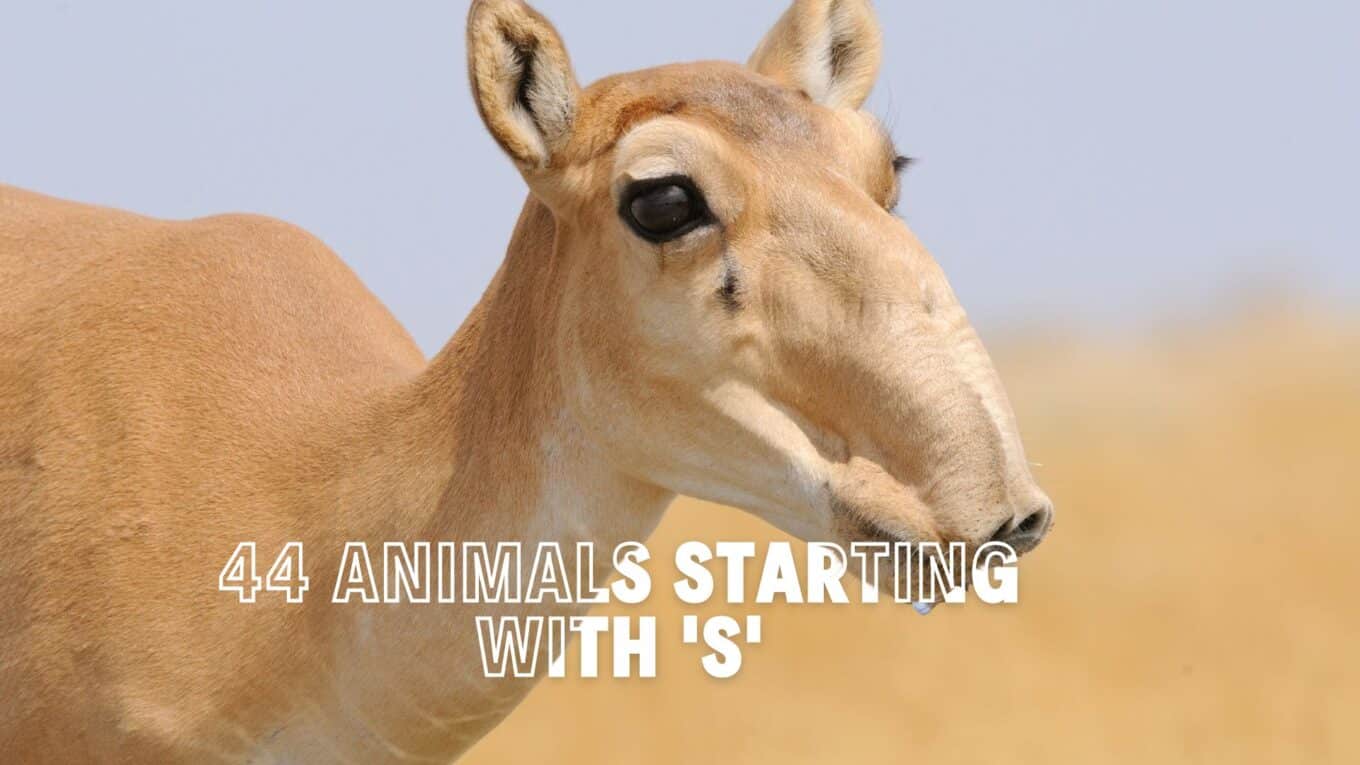Have you ever tried to list animals by their first letter? It’s a fun game that can teach us about the vast world of wildlife. Today, we’re focusing on animals, which start with the letter ‘S.’
You might immediately think of a few common ones, like snakes or squirrels. But there are many more interesting creatures in this group.
In this article, we’ll introduce you to 44 animals whose names begin with ‘S.’ You’ll learn about mammals, birds, fish, and insects. Some might be familiar, while others could surprise you.
Get ready to expand your animal knowledge. Let’s explore these mesmerizing ‘S’ animals, from sea creatures to land inhabitants.
A Collection of Over 40 Animals that Begin with ‘S’
1. Swordfish
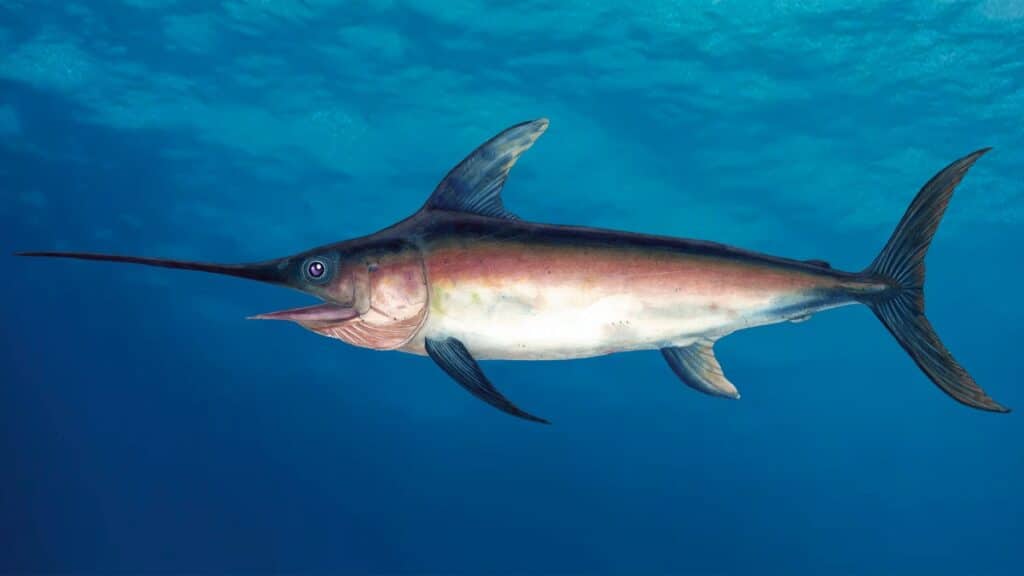
The swordfish is a large, elongated fish known for its distinctive sword-like bill. Its sleek, muscular body is typically bluish-grey on top and silvery-white on the bottom.
Swordfish can grow up to 4.5 meters in length and weigh 650 kilograms.
- Region of Habitat: Tropical and Temperate Oceans
- Scientific Name: Xiphias gladius
- Place of Origin: Global
- Feeding Habits: Carnivorous – Primarily feeds on smaller fish and squid
- What Sound They Make: Generally silent, but can make sounds during feeding
Fun Facts: Swordfish are among the fastest fish in the ocean, reaching speeds up to 60 mph. Their “swords” are used to slash at prey, making it easier to catch.
Unlike many fish, swordfish can regulate their body temperature, allowing them to hunt in colder waters.
2. Swan

Swans are large waterfowl with long necks, white plumage, and orange beaks with black markings. They typically weigh between 7 and 15 kilograms and can have a wingspan of up to 2.4 meters.
- Region of Habitat: Lakes, Ponds, and Rivers
- Scientific Name: Cygnus
- Place of Origin: Northern Hemisphere
- Feeding Habits: Herbivorous – Feeds on aquatic plants, insects, and small fish
- What Sound They Make: Trumpeting or honking sounds
Fun Facts: Swans are known for their strong pair bonds, often mating for life. They are highly territorial and will aggressively defend their nests.
Swans symbolize love and fidelity in some cultures due to their lifelong monogamous relationships.
3. Surgeonfish

Surgeonfish are small to medium-sized fish known for the sharp, scalpel-like spines on their tails. They are brightly colored and typically reach 40 centimeters long, weighing around 1 kilogram.
- Region of Habitat: Coral Reefs in Tropical Oceans
- Scientific Name: Acanthuridae
- Place of Origin: Indo-Pacific region
- Feeding Habits: Herbivorous – Feeds primarily on algae
- What Sound They Make: Generally silent, but may produce clicks
Fun Facts: The sharp spines on their tails are used for defense and can inflict painful wounds. Despite their small size, surgeonfish are vital for maintaining the health of coral reefs by controlling algae growth.
4. Superworm
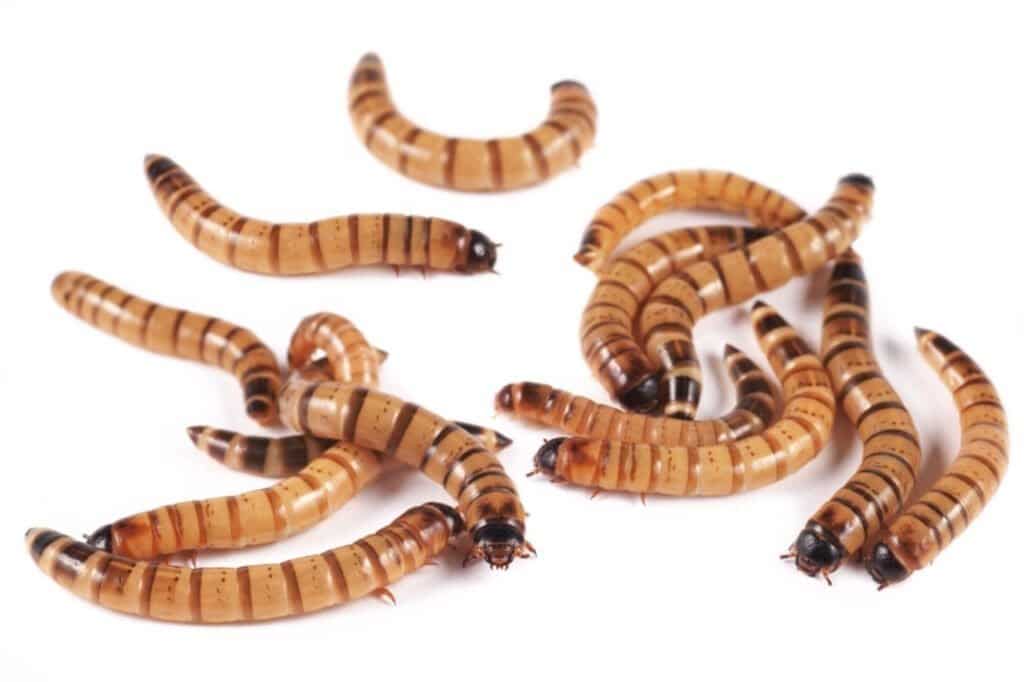
Superworms are the larvae of darkling beetles. They are cylindrical, with a yellow-brown exoskeleton, and can grow up to 6 centimeters in length.
- Region of Habitat: Tropical and Subtropical Regions
- Scientific Name: Zophobas morio
- Place of Origin: Central and South America
- Feeding Habits: Omnivorous – Feeds on grains, vegetables, and decaying organic matter
- What Sound They Make: Silent, but may make faint rustling noises
Fun Facts: Superworms are often used as food for reptiles, birds, and fish. They are high in protein and fat, making them an excellent source of nutrition.
Unlike other insect larvae, superworms are slow to pupate, so they are popular as feeder insects.
5. Sun Bear

Sun bears are small bears with short black fur and a distinct yellow or white crescent shape on their chest. They typically weigh between 27 and 65 kilograms and stand about 70 centimeters tall at the shoulder.
- Region of Habitat: Tropical Forests in Southeast Asia
- Scientific Name: Helarctos malayanus
- Place of Origin: Southeast Asia
- Feeding Habits: Omnivorous – Feeds on fruits, insects, and small vertebrates
- What Sound They Make: Growls, roars, and barks
Fun Facts: Sun bears are the smallest of all bear species and are excellent climbers, often found resting in trees. They have long tongues, which they use to extract honey from beehives, earning them the nickname “honey bears.”
6. Sumatran Tiger
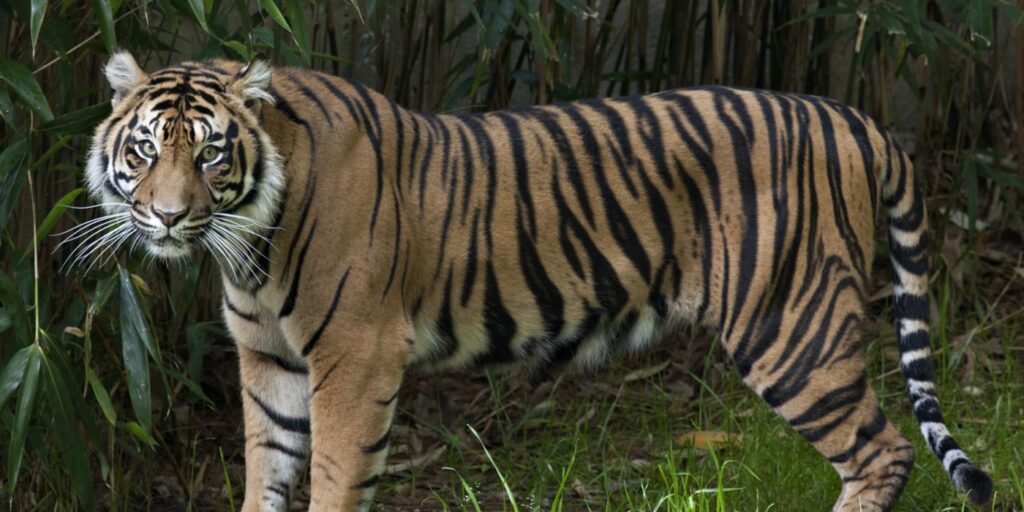
Sumatran tigers are the smallest subspecies of tigers. They have a distinctive orange coat and black stripes. They typically weigh between 100 and 140 kilograms and can be up to 2.5 meters long from head to tail.
- Region of Habitat: Tropical Forests of Sumatra
- Scientific Name: Panthera tigris sumatrae
- Place of Origin: Sumatra, Indonesia
- Feeding Habits: Carnivorous – Hunts large mammals like deer and wild boar
- What Sound They Make: Roars, growls, and chuffs
Fun Facts: Sumatran tigers are critically endangered, with fewer than 400 individuals left in the wild. They are known for their strong swimming ability and are often seen crossing rivers in their dense jungle habitat.
7. Sumatran Rhinoceros
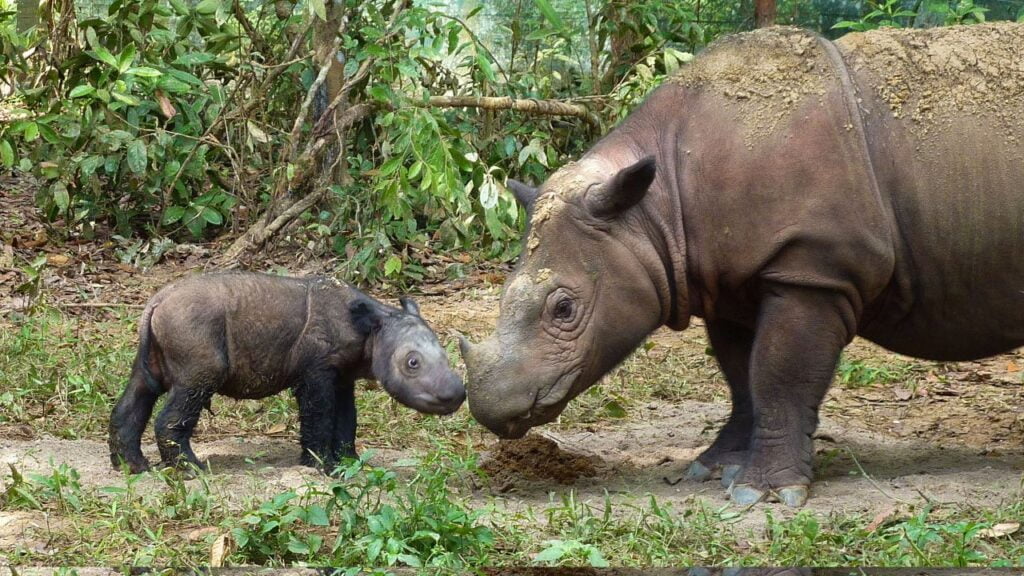
Sumatran rhinoceroses are the smallest of the living rhinoceroses, with a reddish-brown coat and two horns. They typically weigh between 500 and 800 kilograms and stand about 1.5 meters tall at the shoulder.
- Region of Habitat: Dense Tropical Forests in Sumatra and Borneo
- Scientific Name: Dicerorhinus sumatrensis
- Place of Origin: Sumatra and Borneo
- Feeding Habits: Herbivorous – Feeds on leaves, fruits, and twigs
- What Sound They Make: Whistles, whines, and bleats
Fun Facts: The Sumatran rhinoceros is critically endangered, with fewer than 80 individuals left in the wild. They are solitary animals, spending much of their time in mud wallows to keep cool and avoid insects.
8. Sumatran Orangutan
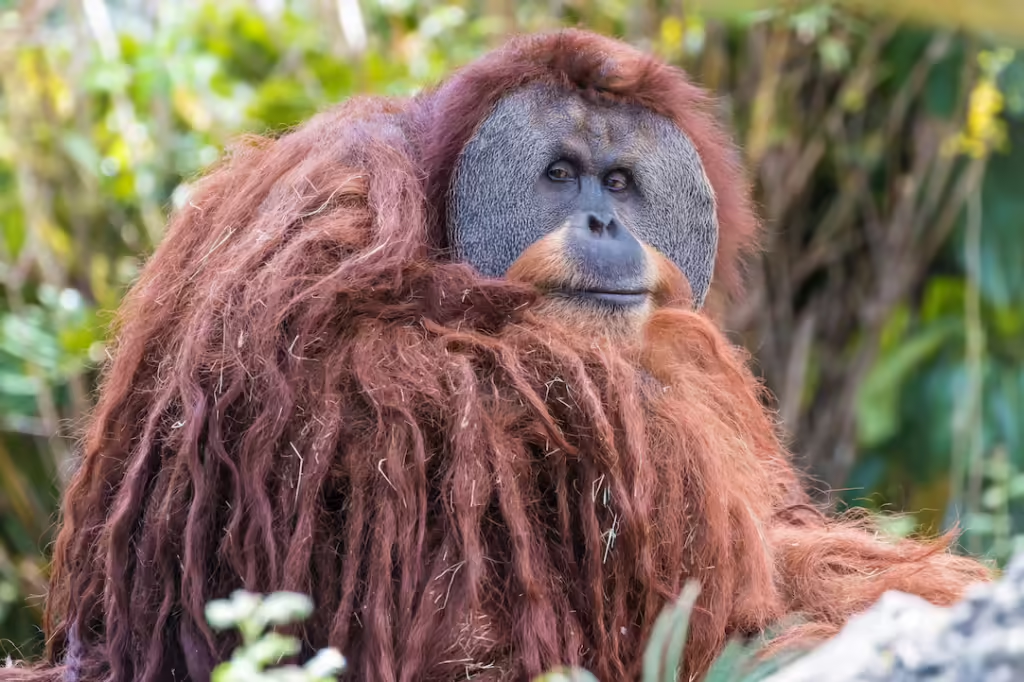
Sumatran orangutans have long, shaggy, reddish fur and are great, intelligent apes. Adult males typically weigh between 50 and 90 kilograms and can have an arm span of over 2 meters.
- Region of Habitat: Tropical Rainforests of Sumatra
- Scientific Name: Pongo abelii
- Place of Origin: Sumatra, Indonesia
- Feeding Habits: Omnivorous – Feeds on fruits, leaves, and insects
- What Sound They Make: Calls, grunts, and long calls by males
Fun Facts: Sumatran orangutans are critically endangered, with habitat loss being their biggest threat. They are the most arboreal of the great apes, spending most of their lives in trees and using tools to obtain food.
9. Styracosaurus
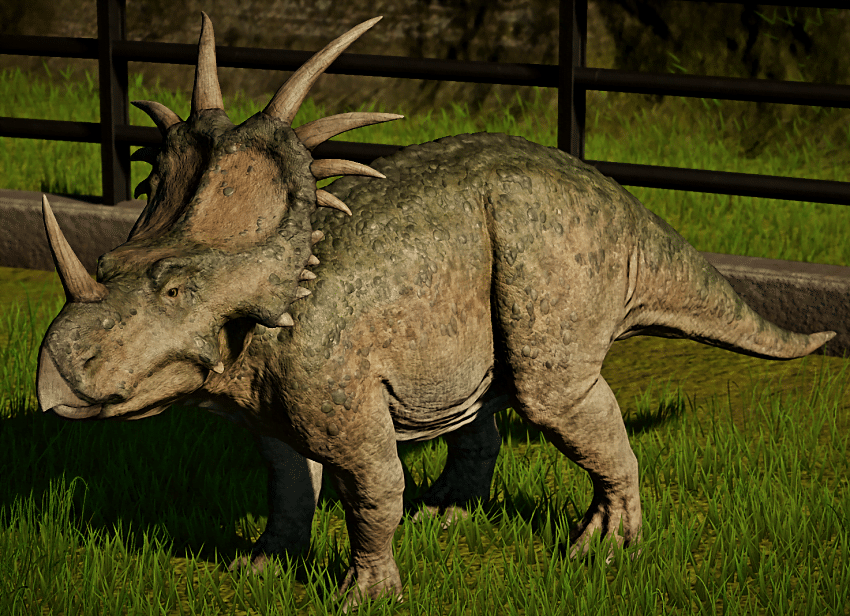
Styracosaurus was a herbivorous dinosaur with a large frill and six long spikes extending from its neck. It weighed approximately 3 tons and measured about 5.5 meters in length.
- Region of Habitat: Late Cretaceous period in North America
- Scientific Name: Styracosaurus albertensis
- Place of Origin: Western North America
- Feeding Habits: Herbivorous – Fed on ferns, cycads, and other vegetation
- What Sound They Make: Roars and low-frequency calls (speculated)
Fun Facts: Styracosaurus is known for its impressive array of facial spikes, which may have been used for defense or display. Fossils of this dinosaur have been found in the Dinosaur Park Formation in Alberta, Canada.
10. Sturgeon

Sturgeons are large, long-lived fish with bony plates along their bodies. They can grow up to 7 meters long and weigh over 1,000 kilograms.
- Region of Habitat: Rivers, Lakes, and Coastal Waters in the Northern Hemisphere
- Scientific Name: Acipenseridae
- Place of Origin: Eurasia and North America
- Feeding Habits: Carnivorous – Feeds on small fish, mollusks, and crustaceans
- What Sound They Make: Generally silent
Fun Facts: Sturgeons are known for producing caviar, a highly prized delicacy made from their eggs. These ancient fish have existed for over 200 million years, making them one of the oldest living species.
11. Stork

Storks are large, long-legged, wading birds with long necks and beaks. They typically weigh between 2 and 4 kilograms and can have a wingspan of up to 3 meters.
- Region of Habitat: Wetlands, Marshes, and Floodplains
- Scientific Name: Ciconiidae
- Place of Origin: Africa, Asia, Europe
- Feeding Habits: Carnivorous – Feeds on fish, frogs, and small mammals
- What Sound They Make: Clattering of bills, no vocal cords
Fun Facts: Storks are associated with many myths and legends, often representing good luck or babies’ arrival.
They are migratory birds, with some species traveling thousands of kilometers between breeding and wintering grounds.
12. Stoat
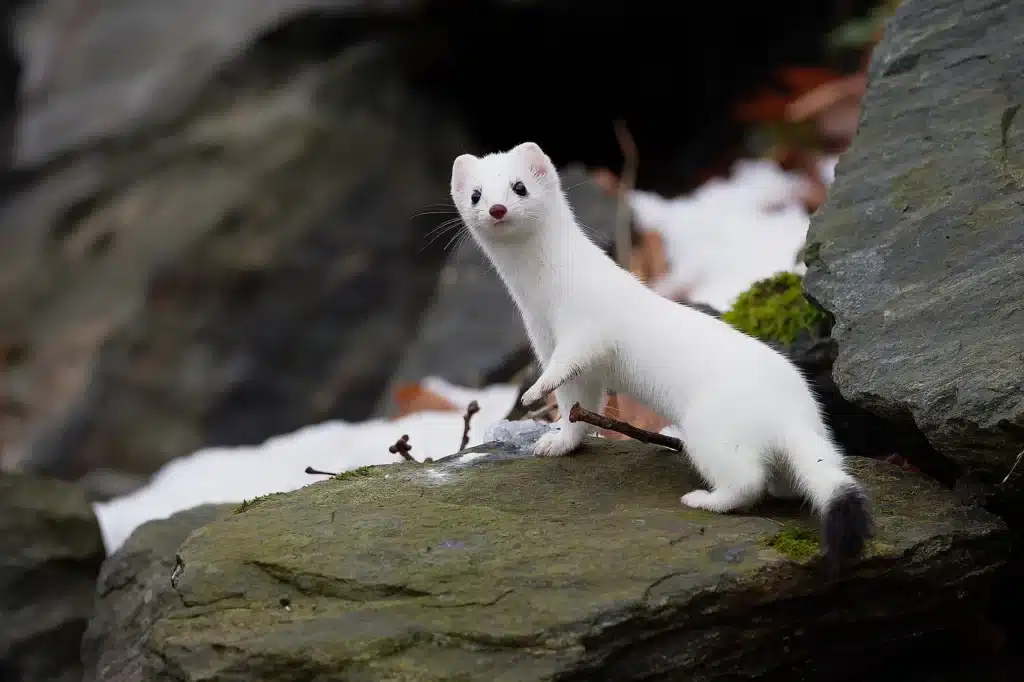
Stoats are small, deft mammals with long, slender bodies and bushy tails. They typically weigh between 200 and 400 grams and measure about 30 centimeters in length.
- Region of Habitat: Woodlands, Grasslands, and Farmlands
- Scientific Name: Mustela erminea
- Place of Origin: Eurasia and North America
- Feeding Habits: Carnivorous – Feeds on small mammals, birds, and insects
- What Sound They Make: High-pitched squeals and chirps
Fun Facts: Stoats are known for their boldness and deftness, capable of taking down prey much larger than themselves. In winter, their fur turns white, which helps them blend into snowy environments.
13. Starfish

Starfish, also known as sea stars, are marine invertebrates with five or more arms radiating from a central disc. They vary in size, with some species reaching up to 25 centimeters in diameter.
- Region of Habitat: Oceans Worldwide
- Scientific Name: Asteroidea
- Place of Origin: Global
- Feeding Habits: Carnivorous – Feeds on mollusks and other small invertebrates
- What Sound They Make: Silent
Fun Facts: Starfish can regenerate lost arms; in some cases, an entire starfish can grow from a single arm. They have no brain or blood and use a water vascular system to move and feed.
14. Stag Beetle

Stag beetles are large beetles with prominent mandibles that resemble deer antlers. They typically measure between 5 and 12 centimeters in length.
- Region of Habitat: Woodlands and Forests
- Scientific Name: Lucanidae
- Place of Origin: Europe, Asia, and North America
- Feeding Habits: Herbivorous – Feeds on tree sap and decaying wood
- What Sound They Make: Rustling and clicking noises
Fun Facts: Male stag beetles use their large mandibles to fight over mates and territory. Despite their fearsome appearance, they are harmless to humans and play an important role in the ecosystem by breaking down dead wood.
15. Squirrel Monkey
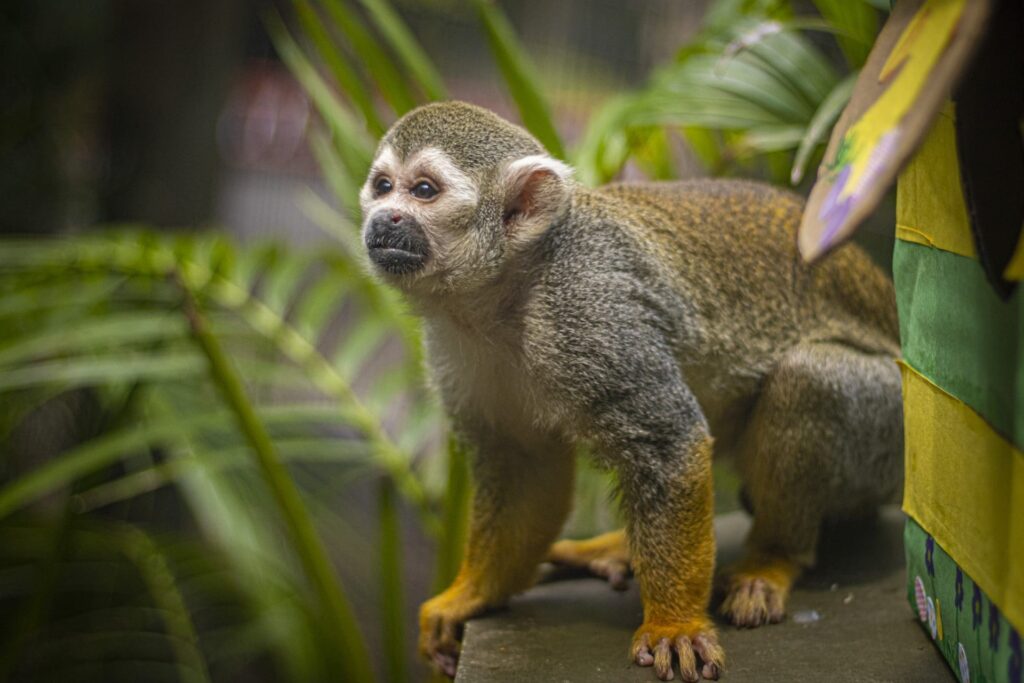
Squirrel monkeys are small primates with short, soft fur and a long tail. They typically weigh between 500 and 1,100 grams and measure about 25 to 35 centimeters in length.
- Region of Habitat: Tropical Rainforests in Central and South America
- Scientific Name: Saimiri
- Place of Origin: Central and South America
- Feeding Habits: Omnivorous – Feeds on fruits, insects, and small vertebrates
- What Sound They Make: Chirps, whistles, and barks
Fun Facts: Squirrel monkeys live in large social groups and are highly active, spending most of their time in the trees. They have excellent vision, which helps them spot predators and find food.
16. Squirrel
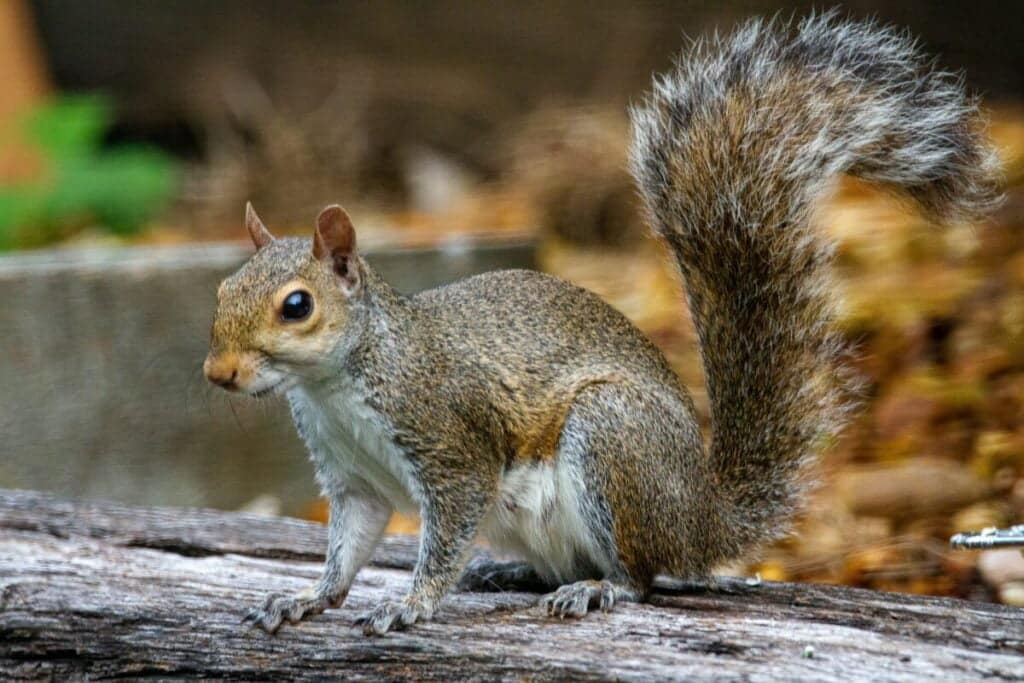
Squirrels are small rodents with bushy tails and sharp claws. They typically weigh between 300 and 700 grams and measure up to 30 centimeters in length.
- Region of Habitat: Forests, Woodlands, and Urban Areas
- Scientific Name: Sciuridae
- Place of Origin: Global
- Feeding Habits: Omnivorous – Feeds on nuts, seeds, fruits, and insects
- What Sound They Make: Chattering and squeaking
Fun Facts: Squirrels are known for burying nuts, which helps tree dispersal. Their strong hind legs and excellent climbing skills make them deft and fast tree movers.
17. Springbok
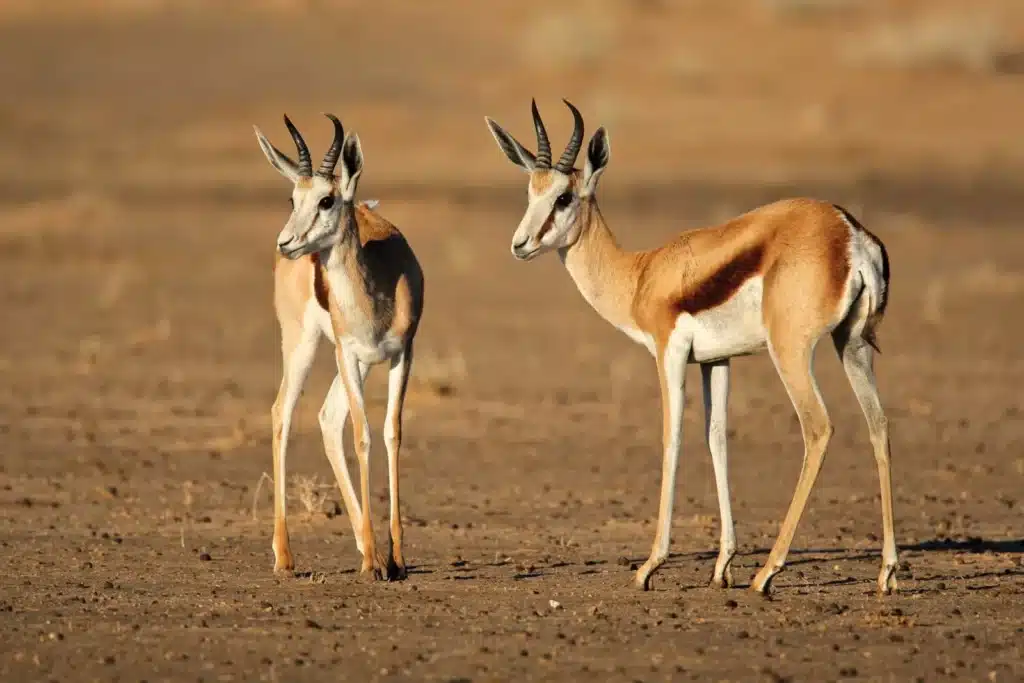
Springboks are medium-sized antelopes with slender bodies, long legs, and a distinct white stripe on their face. They typically weigh between 30 and 50 kilograms and stand about 75 centimeters tall at the shoulder.
- Region of Habitat: Savannas and Deserts in Southern Africa
- Scientific Name: Antidorcas marsupialis
- Place of Origin: Southern Africa
- Feeding Habits: Herbivorous – Feeds on grasses and shrubs
- What Sound They Make: Snorts and grunts
Fun Facts: Springboks are known for their incredible speed and agility. They can leap up to 3.5 meters in the air, a behavior known as pronking. They are also the national animal of South Africa.
18. Spider Monkey
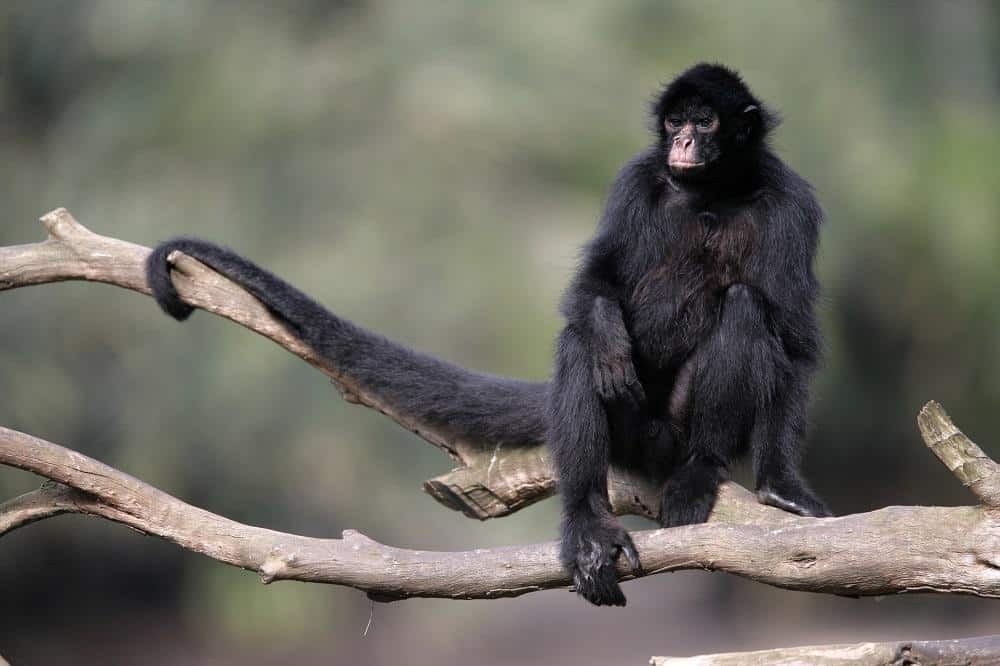
Spider monkeys are large primates with long limbs and a prehensile tail. They typically weigh between 6 and 9 kilograms and measure up to 66 centimeters in length, excluding the tail.
- Region of Habitat: Tropical Rainforests in Central and South America
- Scientific Name: Ateles
- Place of Origin: Central and South America
- Feeding Habits: Omnivorous – Feeds on fruits, nuts, and small vertebrates
- What Sound They Make: Barks, screeches, and grunts
Fun Facts: Spider monkeys are highly deft and use their prehensile tail as a fifth limb to swing through trees. They live in large social groups and communicate using a variety of vocalizations.
19. Spider
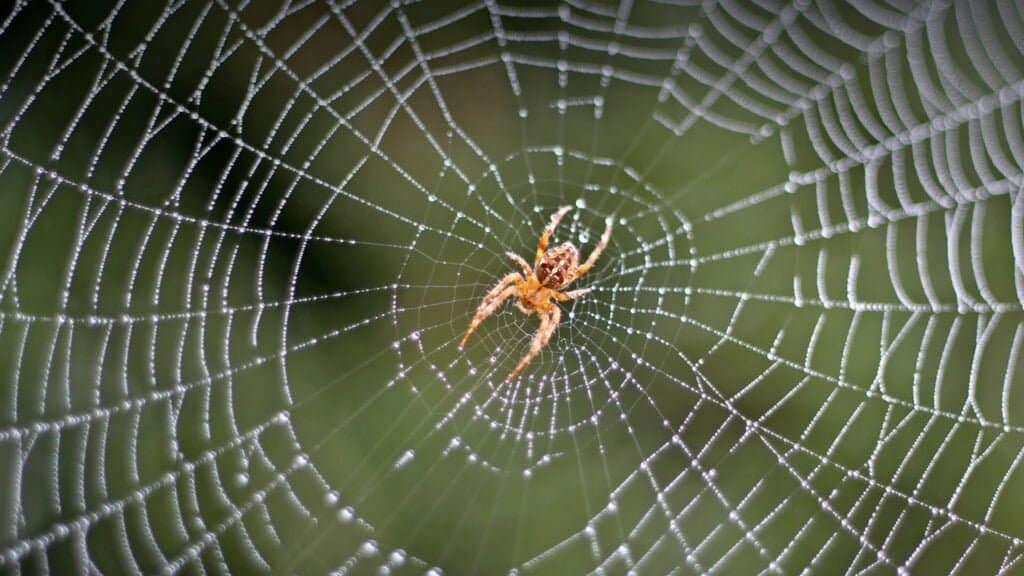
Spiders are arachnids with eight legs that vary greatly in size and color. Some species can be as small as a few millimeters, while others can reach up to 30 centimeters in leg span.
- Region of Habitat: Worldwide, in Various Habitats
- Scientific Name: Araneae
- Place of Origin: Global
- Feeding Habits: Carnivorous – Feeds on insects and other small animals
- What Sound They Make: Generally silent, some species may produce hissing or vibrating noises
Fun Facts: Spiders are known for their silk-spinning abilities, creating webs to catch prey. Some spiders can produce different types of silk for various purposes, including web construction and egg protection.
20. Sperm Whale
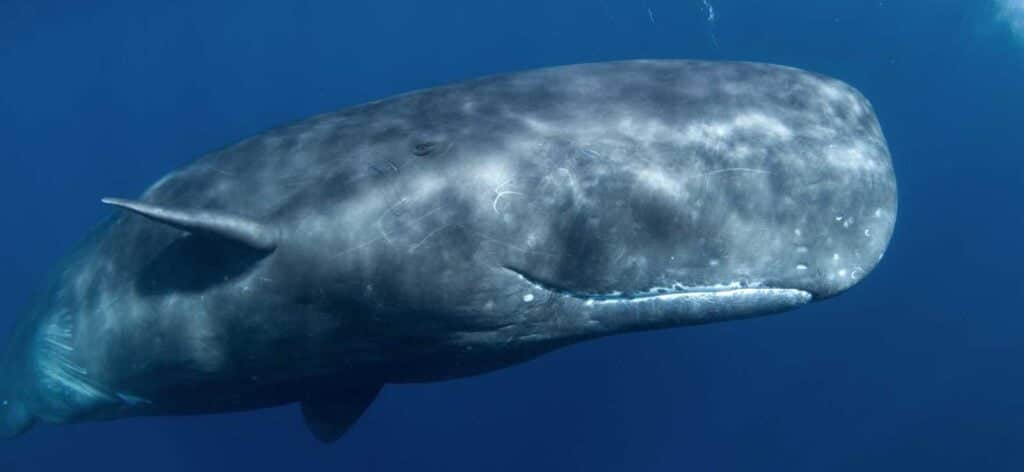
Sperm whales are the largest toothed whales, with a massive head that makes up one-third of their body length. They can grow up to 20 meters long and weigh up to 57,000 kilograms.
- Region of Habitat: Oceans Worldwide
- Scientific Name: Physeter macrocephalus
- Place of Origin: Global
- Feeding Habits: Carnivorous – Feeds primarily on squid
- What Sound They Make: Clicks and echolocation clicks
Fun Facts: Sperm whales have the largest brains of any animal on Earth. They are also known for their deep diving capabilities, reaching depths of over 2,000 meters in search of prey.
21. Snowy Owl
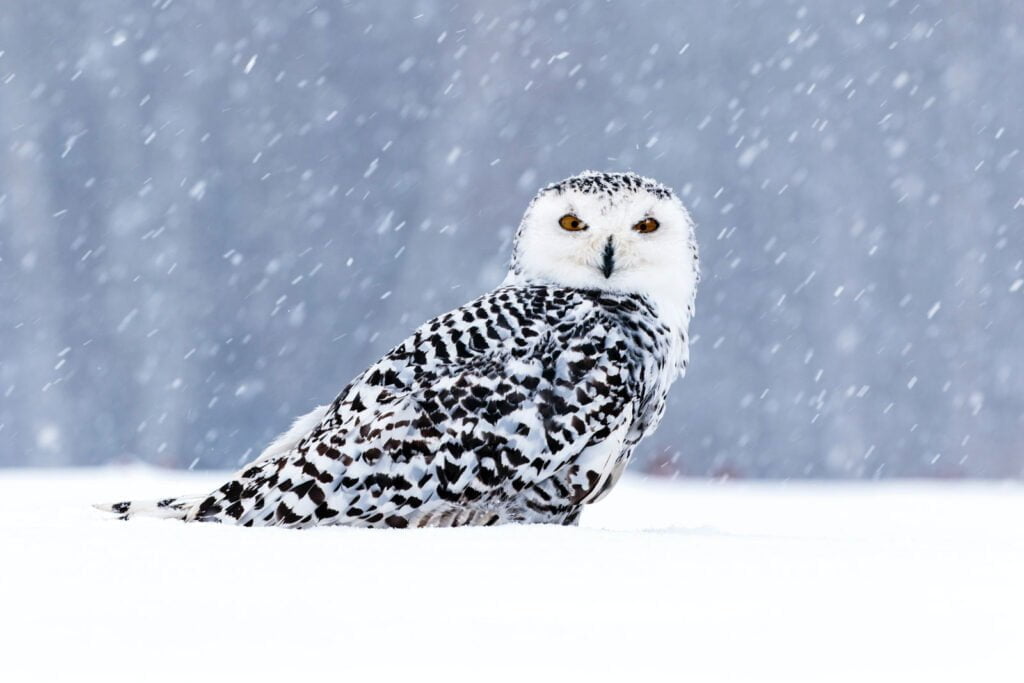
Snowy owls are large, white birds with yellow eyes and a round face. They typically weigh between 1.6 and 3 kilograms and have a wingspan of up to 1.5 meters.
- Region of Habitat: Arctic Regions and Northern Tundra
- Scientific Name: Bubo scandiacus
- Place of Origin: Arctic
- Feeding Habits: Carnivorous – Feeds on lemmings, small mammals, and birds
- What Sound They Make: Hooting and screeching
Fun Facts: Snowy owls are well adapted to cold environments, with thick feathers covering their legs and toes. They are also excellent hunters, known for their silent flight and sharp vision.
22. Snow Leopard
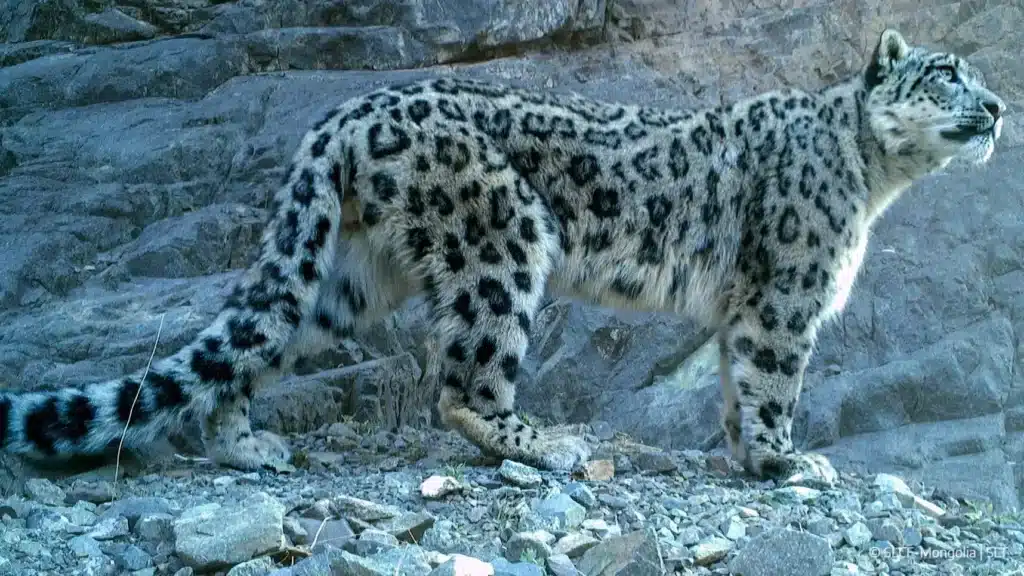
Snow leopards are large cats with thick fur and long tails, perfectly adapted to cold mountainous environments. They typically weigh between 22 and 55 kilograms and measure up to 1.2 meters long, excluding the tail.
- Region of Habitat: Mountain Ranges in Central and South Asia
- Scientific Name: Panthera uncia
- Place of Origin: Central and South Asia
- Feeding Habits: Carnivorous – Feeds on mountain sheep, goats, and other small mammals
- What Sound They Make: Yowls, growls, and purrs
Fun Facts: Snow leopards are often called “ghosts of the mountains” due to their elusive nature. They can leap up to 15 meters in a single bound, helping them guide the rocky terrain of their habitat.
23. Snow Goose
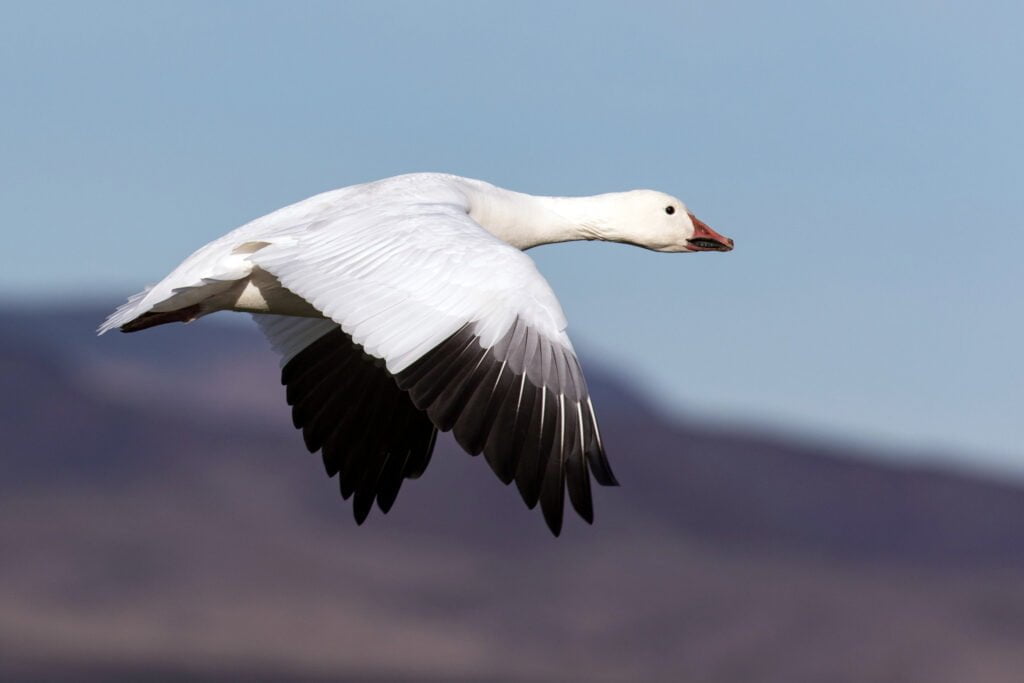
Snow geese are medium-sized waterfowl with white plumage and black wingtips. They typically weigh between 2 and 3 kilograms and have a wingspan of up to 1.7 meters.
- Region of Habitat: Tundra and Coastal Marshes
- Scientific Name: Anser caerulescens
- Place of Origin: North America
- Feeding Habits: Herbivorous – Feeds on grasses, grains, and roots
- What Sound They Make: Honking
Fun Facts: Snow geese are highly migratory, traveling thousands of kilometers between their breeding and wintering grounds. They often form large flocks, seen in the skies during migration.
24. Snapping Turtle

Snapping turtles are large freshwater turtles with powerful jaws and a rugged appearance. They typically weigh between 4.5 and 16 kilograms and have a shell length of up to 50 centimeters.
- Region of Habitat: Freshwater Bodies in North America
- Scientific Name: Chelydra serpentina
- Place of Origin: North America
- Feeding Habits: Omnivorous – Feeds on fish, plants, and small mammals
- What Sound They Make: Hissing
Fun Facts: Snapping turtles are known for their aggressive nature. When threatened, they snap their jaws with incredible force. They have long lifespans, with some individuals living for over 100 years.
25. Sloth
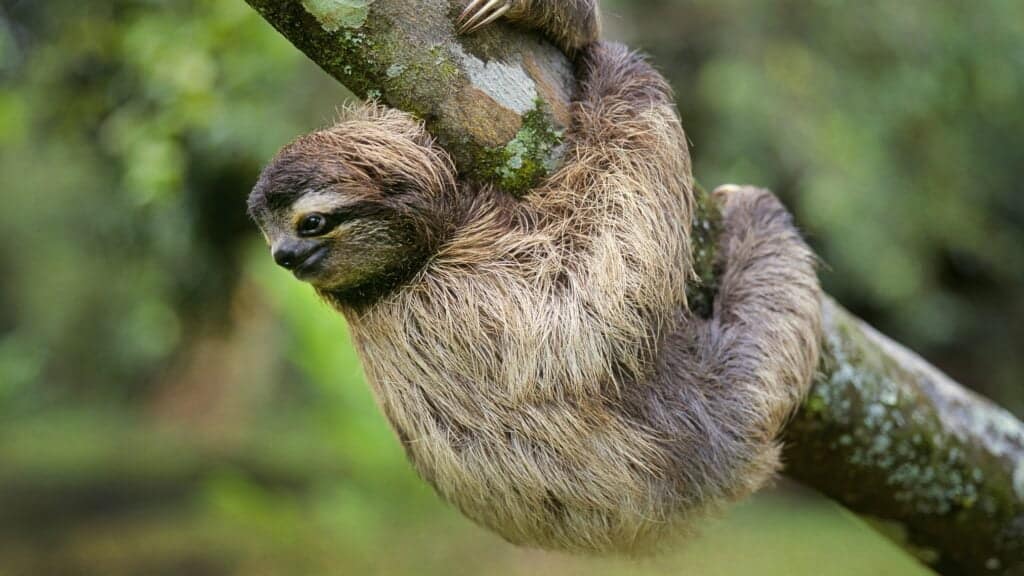
Sloths are slow-moving mammals with long limbs and a shaggy coat. They typically weigh between 4 and 8 kilograms and measure up to 70 centimeters in length.
- Region of Habitat: Tropical Rainforests in Central and South America
- Scientific Name: Folivora
- Place of Origin: Central and South America
- Feeding Habits: Herbivorous – Feeds on leaves, fruits, and flowers
- What Sound They Make: Soft calls and hisses
Fun Facts: Sloths spend most of their lives hanging upside down in trees, moving slowly to conserve energy. They have a low metabolism and only come down from the trees once a week to defecate.
26. Siberian Tiger
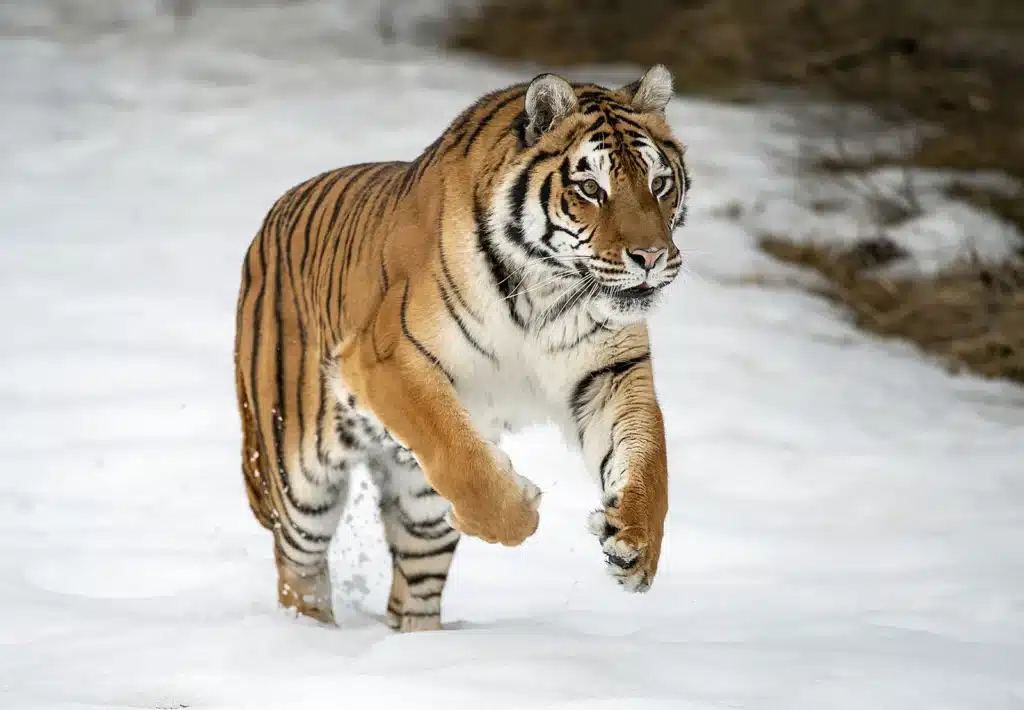
Siberian tigers are the largest of all tiger subspecies. They have a thick orange coat and black stripes. They typically weigh between 180 and 306 kilograms and can be up to 3.3 meters long from head to tail.
- Region of Habitat: Forests in Eastern Russia and Northeast China
- Scientific Name: Panthera tigris altaica
- Place of Origin: Eastern Russia
- Feeding Habits: Carnivorous – Hunts large mammals like deer and wild boar
- What Sound They Make: Roars, growls, and chuffs
Fun Facts: Siberian tigers are adapted to cold environments, with a thick layer of fat and dense fur to keep them warm. They are solitary animals, with each tiger having a large territory that it fiercely defends.
27. Siberian Husky

Siberian Huskies are medium-sized working dogs with thick fur, erect ears, and distinctive markings. They typically weigh between 16 and 27 kilograms and stand about 53 to 60 centimeters tall at the shoulder.
- Region of Habitat: Cold, Arctic Regions
- Scientific Name: Canis lupus familiaris
- Place of Origin: Siberia, Russia
- Feeding Habits: Omnivorous – Feeds on dog food, meat, and plants
- What Sound They Make: Howls, barks, and whines
Fun Facts: Siberian Huskies are known for their endurance and ability to pull sleds over long distances in harsh conditions. They have a strong prey drive and are known for being escape artists, often digging under fences.
28. Siamese

Siamese cats are slender, medium-sized, with short, fine coats and striking blue eyes. They typically weigh between 3 and 5 kilograms and stand about 20 to 25 centimeters tall at the shoulder.
- Region of Habitat: Domestic
- Scientific Name: Felis catus
- Place of Origin: Thailand (formerly Siam)
- Feeding Habits: Carnivorous – Feeds on cat food and small animals
- What Sound They Make: Meows, yowls, and purrs
Fun Facts: Siamese cats are known for their vocal nature and strong bond with their owners. They are one of the oldest and most recognizable cat breeds, with a history that dates back hundreds of years.
29. Shih Tzu

Shih Tzus are small, sturdy dogs with a long, flowing coat and a distinctive pushed-in face. They typically weigh between 4 and 7 kilograms and stand about 20 to 28 centimeters tall at the shoulder.
- Region of Habitat: Domestic
- Scientific Name: Canis lupus familiaris
- Place of Origin: Tibet
- Feeding Habits: Omnivorous – Feeds on dog food and meat
- What Sound They Make: Barks and whines
Fun Facts: Shih Tzus were bred as companion dogs for Chinese royalty and are known for their affectionate and friendly nature. They require regular grooming to maintain their long coat and are well-suited to indoor living.
30. Shark
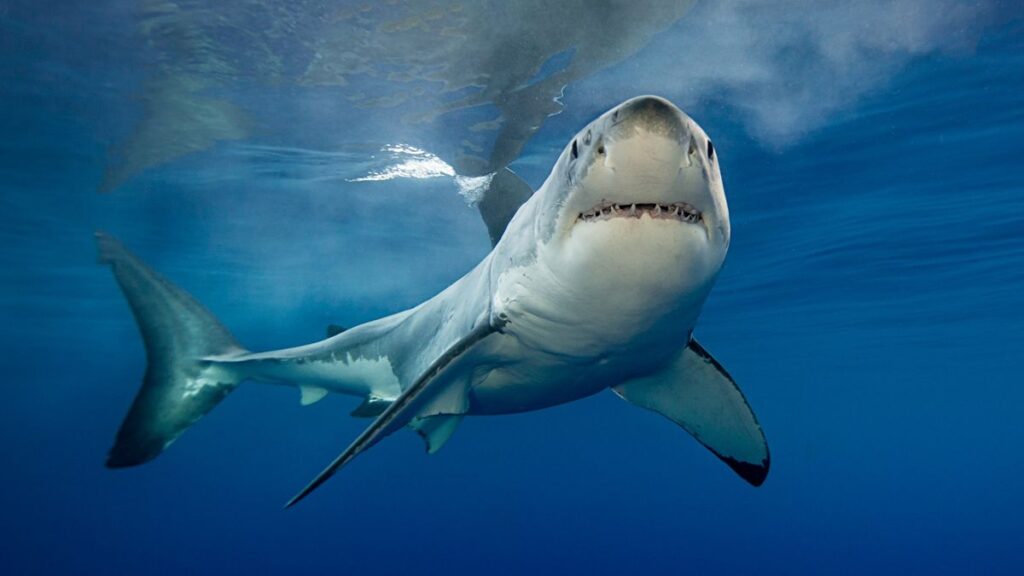
Sharks are a diverse group of fish with cartilaginous skeletons and a streamlined body shape. They vary greatly in size, with some species growing up to 12 meters in length and weighing over 1,100 kilograms.
- Region of Habitat: Oceans Worldwide
- Scientific Name: Selachimorpha
- Place of Origin: Global
- Feeding Habits: Carnivorous – Feeds on fish, seals, and other marine animals
- What Sound They Make: Silent, as sharks lack vocal cords
Fun Facts: Sharks have been around for over 400 million years, making them older than dinosaurs. They are apex predators, playing a crucial role in maintaining the balance of marine ecosystems.
31. Seal
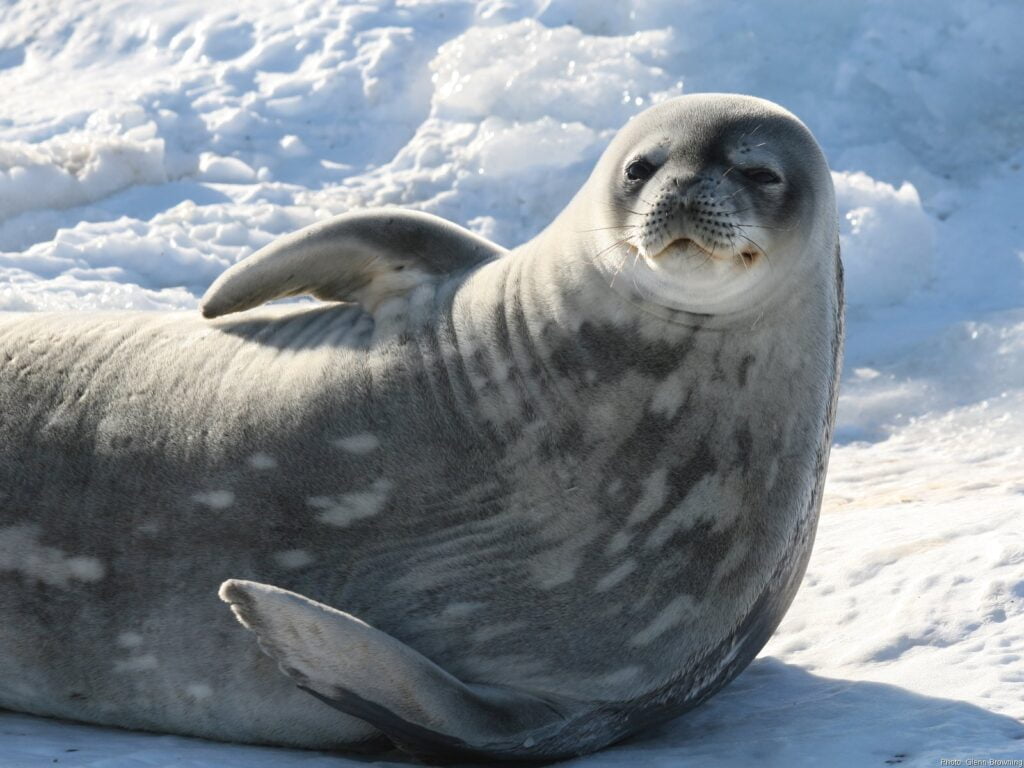
Seals are marine mammals with a streamlined body, flippers, and a thick layer of fat. They typically weigh between 45 and 300 kilograms and can be up to 2.5 meters long.
- Region of Habitat: Coastal Waters Worldwide
- Scientific Name: Pinnipedia
- Place of Origin: Global
- Feeding Habits: Carnivorous – Feeds on fish, squid, and crustaceans
- What Sound They Make: Barks, grunts, and growls
Fun Facts: Seals are excellent swimmers, using their flippers to easily guide the water. They come ashore to rest, breed, and give birth, often forming large colonies on beaches and ice floes.
32. Seahorse
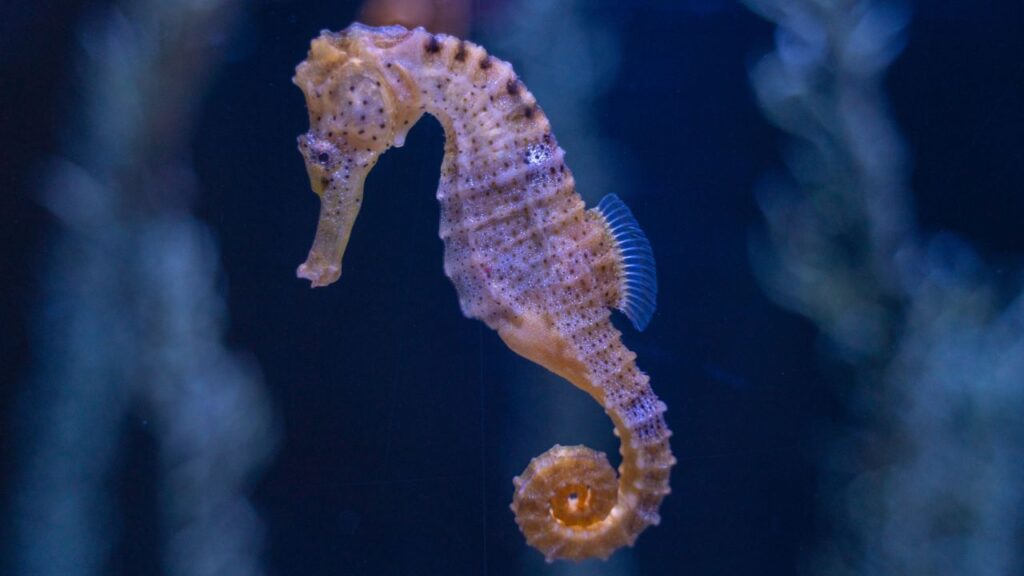
Seahorses are small marine fish with a horse-like head, prehensile tail, and a body covered in bony plates. They typically measure between 2 and 35 centimeters in length.
- Region of Habitat: Shallow Coastal Waters and Seagrass Beds
- Scientific Name: Hippocampus
- Place of Origin: Global
- Feeding Habits: Carnivorous – Feeds on small crustaceans and plankton
- What Sound They Make: Clicking sounds
Fun Facts: Seahorses are unique among fish because the males carry and give birth to the young. They are also known for their monogamous pair bonds, often engaging in daily courtship rituals with their mates.
33. Sea Urchin
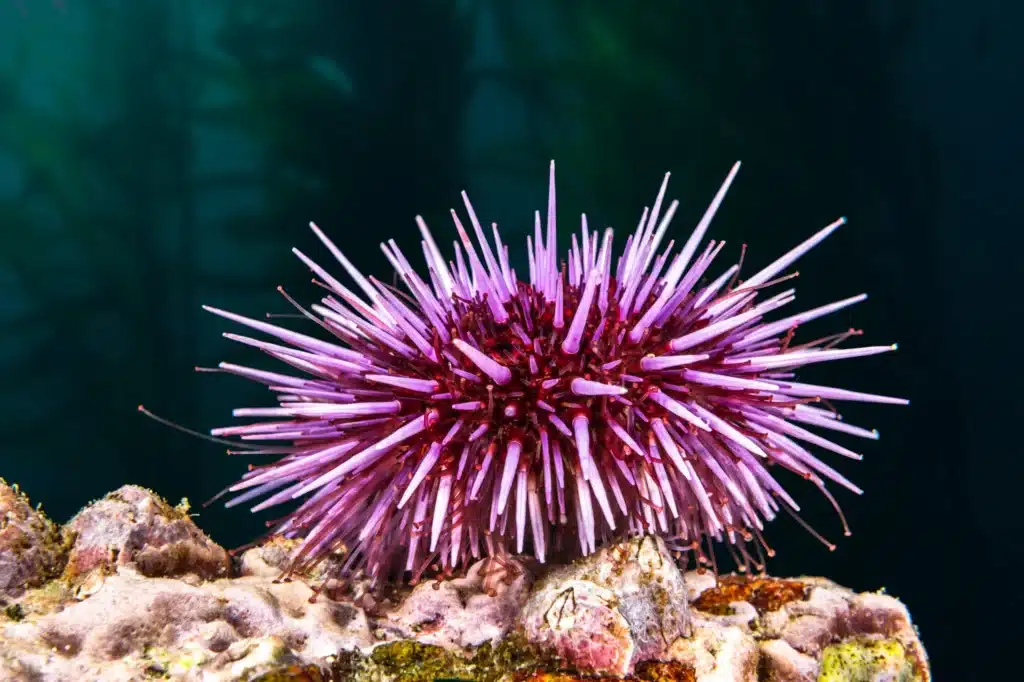
Sea urchins are small, spiny marine animals with a hard shell, typically measuring between 3 and 10 centimeters in diameter.
- Region of Habitat: Oceans Worldwide
- Scientific Name: Echinoidea
- Place of Origin: Global
- Feeding Habits: Herbivorous – Feeds on algae and detritus
- What Sound They Make: Silent
Fun Facts: Sea urchins play a crucial role in maintaining the balance of marine ecosystems by grazing on algae. Their spines can be sharp and venomous, protecting them from predators.
34. Sea Turtle

Sea turtles are large marine reptiles with streamlined shells, flippers, and beaked mouths. They typically weigh between 70 and 700 kilograms and can be up to 2 meters long.
- Region of Habitat: Oceans Worldwide
- Scientific Name: Chelonioidea
- Place of Origin: Global
- Feeding Habits: Omnivorous – Feeds on seagrass, jellyfish, and algae
- What Sound They Make: Silent
Fun Facts: Sea turtles are known for their long migrations, often traveling thousands of kilometers between feeding and nesting grounds.
They have existed for over 100 million years, making them one of the oldest living reptile species.
35. Sea Otter

Sea otters are marine mammals with thick fur, webbed feet, and a playful nature. They typically weigh between 14 and 45 kilograms and measure up to 1.5 meters in length.
- Region of Habitat: Coastal Waters in the North Pacific
- Scientific Name: Enhydra lutris
- Place of Origin: North Pacific Ocean
- Feeding Habits: Carnivorous – Feeds on shellfish, sea urchins, and fish
- What Sound They Make: Whistles, chirps, and growls
Fun Facts: Sea otters are known for using tools like rocks to break open shellfish. They have the thickest fur of any animal, which helps keep them warm in cold ocean waters.
36. Sea Lion

Sea lions are large marine mammals with external ear flaps, long fore flippers, and sleek bodies. They typically weigh between 150 and 300 kilograms and can be up to 2.5 meters long.
- Region of Habitat: Coastal Waters Worldwide
- Scientific Name: Otariinae
- Place of Origin: Global
- Feeding Habits: Carnivorous – Feeds on fish, squid, and octopus
- What Sound They Make: Barks, growls, and roars
Fun Facts: Sea lions are social animals, often seen in large groups called colonies. They are highly intelligent and can be trained to perform tasks, so they are frequently featured in marine shows.
37. Scorpion
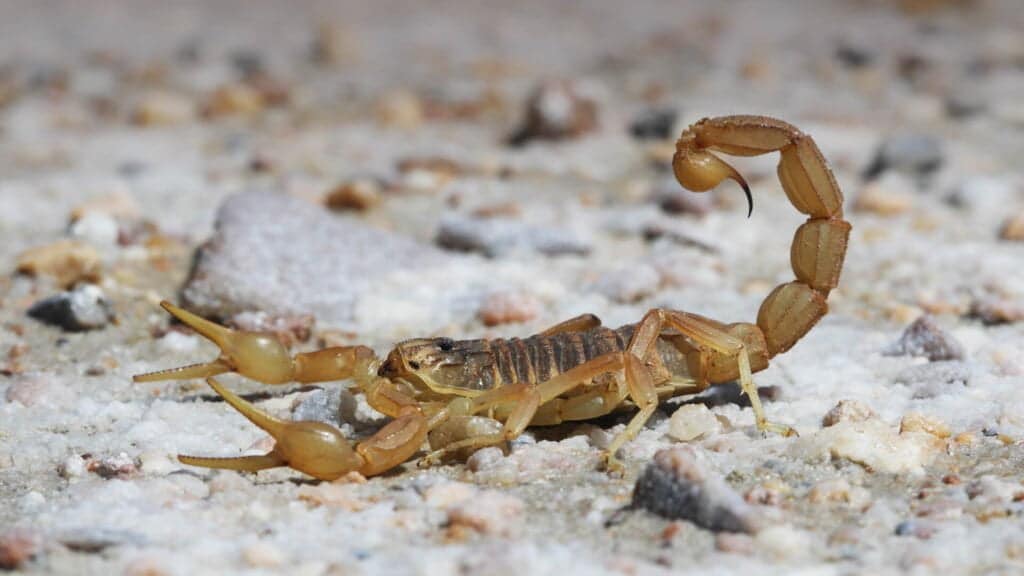
Scorpions are arachnids with a segmented tail that ends in a venomous stinger. They typically measure between 6 and 21 centimeters in length.
- Region of Habitat: Deserts, Forests, and Grasslands
- Scientific Name: Scorpiones
- Place of Origin: Global
- Feeding Habits: Carnivorous – Feeds on insects, spiders, and small vertebrates
- What Sound They Make: Silent
Fun Facts: Scorpions have existed for over 400 million years, making them one of the oldest terrestrial animals.
They are known for their ability to glow under ultraviolet light, a feature that is often used to spot them at night.
38. Scarab Beetle
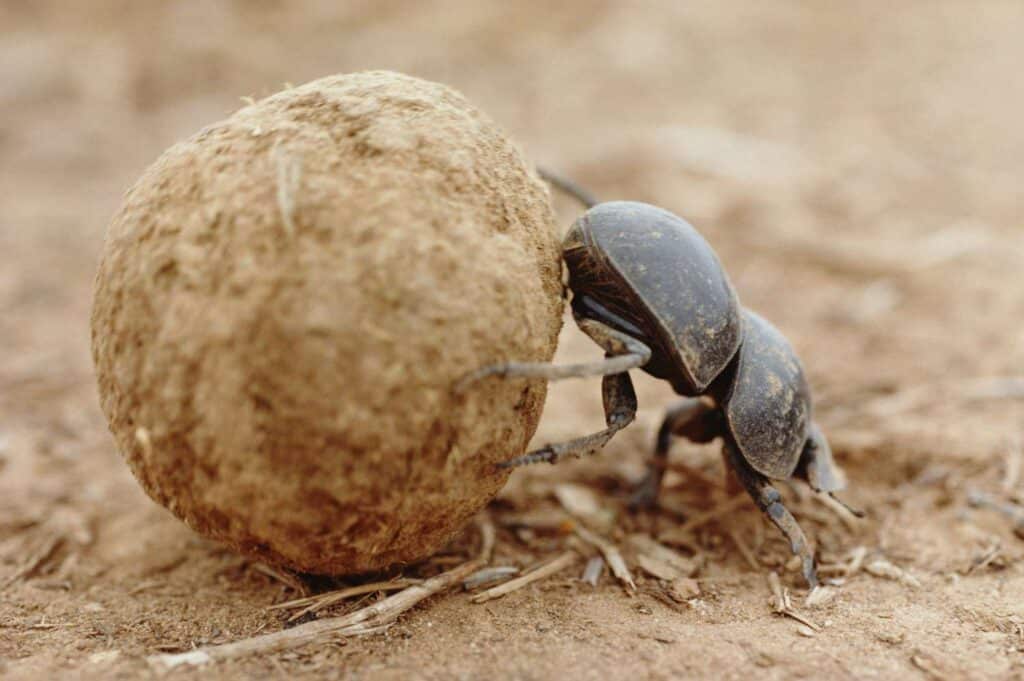
Scarab beetles are stout, oval-shaped beetles with a hard exoskeleton. They typically measure between 1 and 5 centimeters in length.
- Region of Habitat: Deserts, Forests, and Grasslands
- Scientific Name: Scarabaeidae
- Place of Origin: Global
- Feeding Habits: Herbivorous – Feeds on dung, decaying plant matter, and fruits
- What Sound They Make: Buzzing and clicking
Fun Facts: Scarab beetles were considered sacred in ancient Egypt, symbolizing rebirth and the cycle of life. They are also known for breaking down and recycling organic material in the environment.
39. Scallops
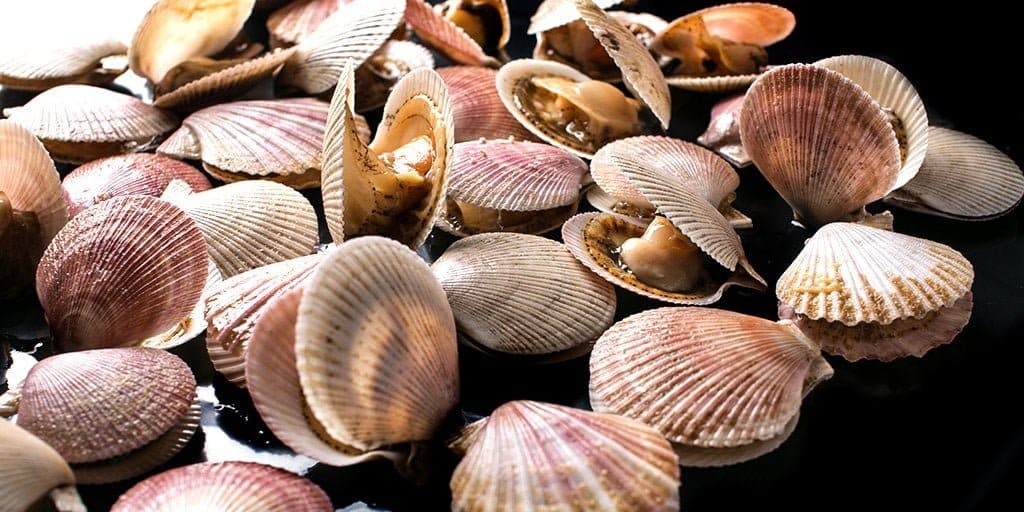
Scallops are bivalve mollusks with a fan-shaped shell, typically measuring between 6 and 20 centimeters in diameter.
- Region of Habitat: Oceans Worldwide
- Scientific Name: Pectinidae
- Place of Origin: Global
- Feeding Habits: Filter feeders – Feeds on plankton and small particles in the water
- What Sound They Make: Silent
Fun Facts: Scallops can swim by rapidly opening and closing their shells, propelling themselves through the water.
They have a row of bright blue eyes along the edge of their mantle, which helps them detect movement and light.
40. Saola
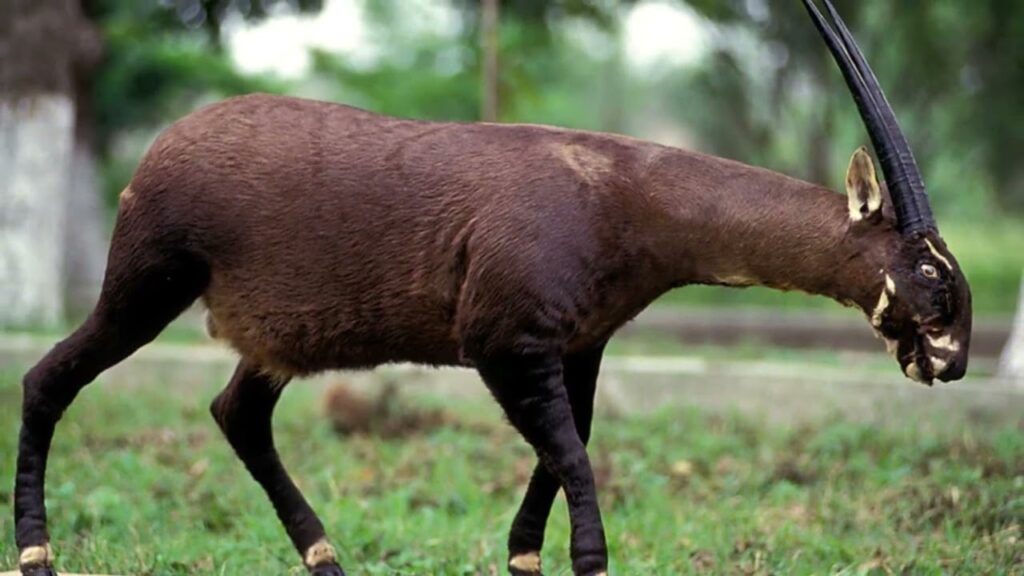
Saolas are large, forest-dwelling bovids with long, straight horns and a dark brown coat. They typically weigh between 80 and 100 kilograms and stand about 85 centimeters tall at the shoulder.
- Region of Habitat: Tropical Forests in Vietnam and Laos
- Scientific Name: Pseudoryx nghetinhensis
- Place of Origin: Vietnam and Laos
- Feeding Habits: Herbivorous – Feeds on leaves, grasses, and shrubs
- What Sound They Make: Generally silent, with occasional low grunts
Fun Facts: Saolas is one of the rarest large mammals on Earth, with only a few sightings since their discovery in 1992.
They are often called the “Asian unicorn” due to their elusive nature and long, straight horns.
41. Sandpiper
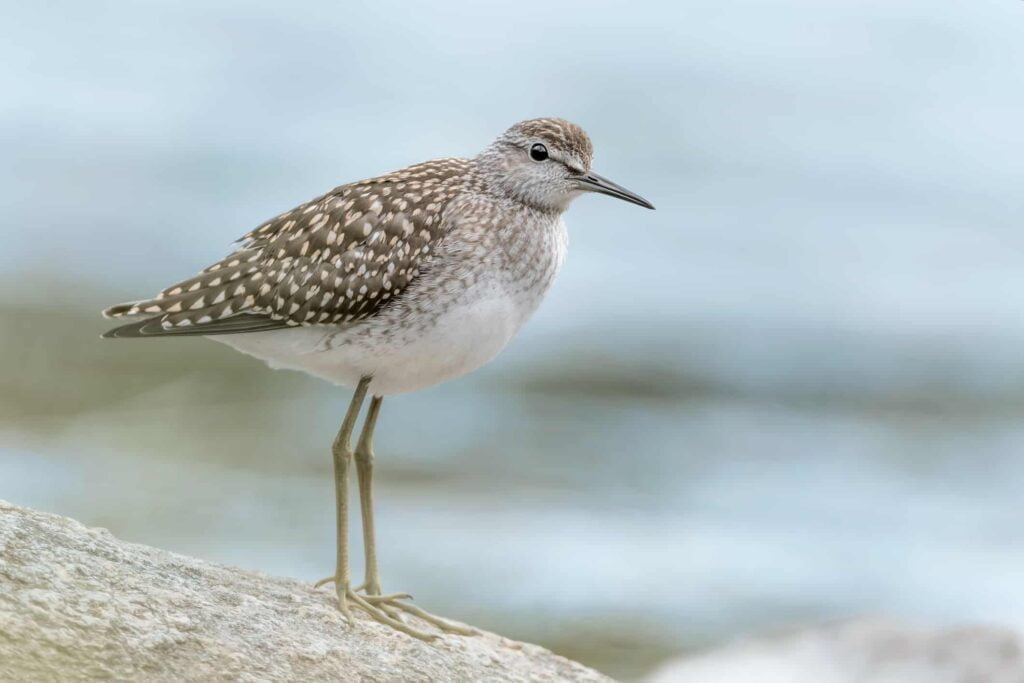
Sandpipers are small to medium-sized shorebirds with long legs and a slender bill. They typically weigh between 20 and 100 grams and measure up to 30 centimeters in length.
- Region of Habitat: Coastal Wetlands and Inland Waterways
- Scientific Name: Scolopacidae
- Place of Origin: Global
- Feeding Habits: Omnivorous – Feeds on insects, crustaceans, and small fish
- What Sound They Make: Trilling and piping calls
Fun Facts: Sandpipers are known for their distinctive, rapid movements as they forage along the water’s edge.
They are highly migratory, with some species traveling thousands of kilometers between breeding and wintering grounds.
42. Samoyed

Samoyeds are large, fluffy dogs with a thick, white coat and a friendly expression. They typically weigh between 20 and 30 kilograms and stand about 50 to 60 centimeters tall at the shoulder.
- Region of Habitat: Cold, Arctic Regions
- Scientific Name: Canis lupus familiaris
- Place of Origin: Siberia, Russia
- Feeding Habits: Omnivorous – Feeds on dog food, meat, and plants
- What Sound They Make: Barks, howls, and whines
Fun Facts: Samoyeds were originally bred to herd reindeer and pull sleds for the Samoyede people of Siberia. They are known for their “Sammy smile,” a characteristic upturned mouth that gives them a friendly appearance.
43. Salamander
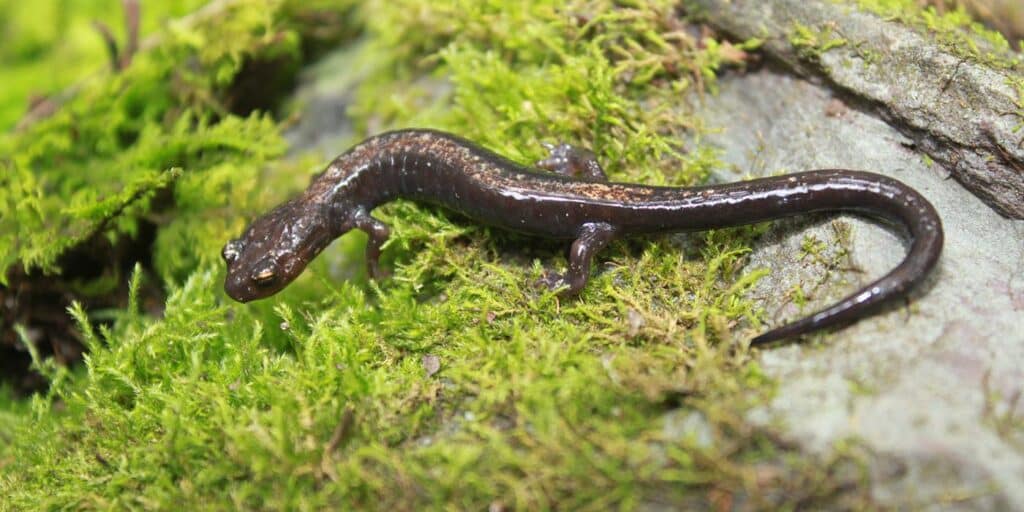
Salamanders are amphibians with lizard-like bodies, moist skin, and long tails. They typically measure between 10 and 20 centimeters in length.
- Region of Habitat: Wetlands, Forests, and Streams
- Scientific Name: Caudata
- Place of Origin: Global
- Feeding Habits: Carnivorous – Feeds on insects, worms, and small fish
- What Sound They Make: Silent
Fun Facts: Salamanders can regenerate lost limbs, a trait that has made them a subject of scientific study. They are highly sensitive to environmental changes and often serve as indicators of ecosystem health.
44. Saiga
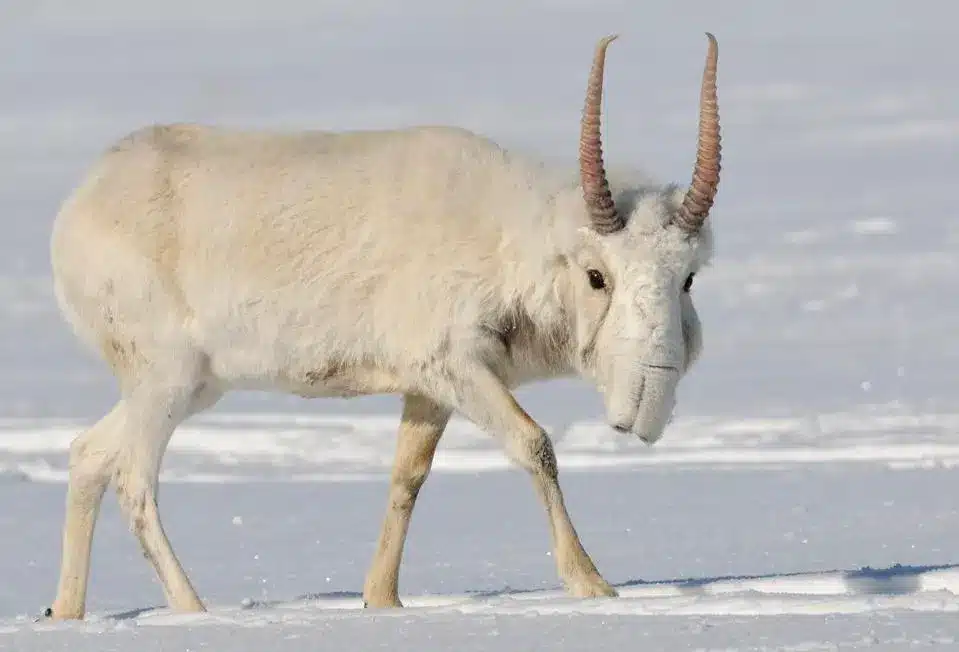
Saigas are antelope with a unique, bulbous nose and a sandy-colored coat. They typically weigh between 25 and 60 kilograms and stand about 60 to 80 centimeters tall at the shoulder.
- Region of Habitat: Steppes and Semi-deserts in Central Asia
- Scientific Name: Saiga tatarica
- Place of Origin: Central Asia
- Feeding Habits: Herbivorous – Feeds on grasses and shrubs
- What Sound They Make: Grunts and snorts
Fun Facts: Saigas are critically endangered, with populations declining due to poaching and habitat loss. Their distinctive nose helps filter dust during migrations and regulate their body temperature in extreme climates.
Wrapping It Up!
We’ve just explored 44 remarkable animals that start with the letter ‘S.’ This list shows how diverse the animal kingdom is, from small snails to large sharks.
Some of these creatures might have been new to you. Others may have been old favorites. Either way, we hope you’ve learned something interesting about each one.
Remember, these 44 animals are a small part of the ‘S’ group. There are many more out there waiting to be found.
Next time you’re at a zoo, aquarium, or out in nature, keep an eye out for these ‘S’ animals. You might spot a squirrel in your backyard or a starfish at the beach.
Learning about animals is fun and important. It helps us understand and care for the world around us. Keep exploring and stay curious about wildlife!

